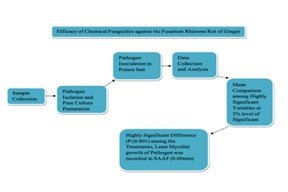Efficacy of chemical fungicides against the fusarium rhizome rot of Ginger (Zingiber officinale)
Abstract
The present investigation was conducted to analyze efficacy of different commercially available fungicides against the Fusarium spp. causing rhizome rot of ginger adopting poison food technique. The experiment was carried out in a completely randomized design (CRD) with 8 treatment and 3 replications. The fungicides SAAF (Carbendazim 12% WP + Mancozeb WP 63%), Nativo (Tebuconazole 50% WP + Trifloxystrobin 25% WP), Caviet (Tebuconazole 25% WP), Kingsin M (Thiophanate –methyl 70%WP), Moximate (Cymoxil 8% WP + Mancozeb 64% WP), Custodia (Azoxystrobin 11% SC + Tebuconazole 18.3% SC), Melody duo (Iprovalicarp 5.5% WP + Probineb 61.5% WP) were used as a treatment for poison food technique. The results of this study indicated that there was a highly significant difference (p≤0.001) among the treatments in mycelial growth of the pathogen and inhibition of pathogen by different fungicides. The maximum mycelial growth of pathogen was observed on control plate (79.67mm) which was followed by melody duo and Moximate with the radial mycelial growth of 57.33mm and 55.83mm, respectively. Whereas the least mycelial growth of pathogen was recorded in SAAF (0.00mm) which was followed by Nativo, Custodia, Caviet and Kingsin M with the radial mycelial growth of 10.33mm, 14.83mm, 15.50, 21.83mm, respectively. Therefore, SAAF fully inhibited the growth of pathogen and found most effective which was followed by Nativo, Custodia, and Caviet with 87.04%, 81.40%, 80.55%, respectively.
Keywords:
Evaluation, Inhibition, Poison food technique, TreatmentsDownloads
References
Ayub, A., Sultana, N., Faruk, M. I., Rahman, M. M., &Mamun, A. N. M. (2009). Control of Rhizome Rot Disease of Ginger (Zingiber officinale Rose) by Chemicals, Soil Amendments and Soil Antagonist. The Agriculturists, 57-61.
Bharati, S., pant, c., & Sushma, P. (2019). Evaluation and Selection of Different Management Practices of Ginger. International Journal of Graduate Research Review, 131-134
Booth, C. (1971). "The genus Fusarium Commonwealth Mycological Institute, Kew Survey." England 237pp
Dahal, N., & Shrestha, R. K. (2018). Evaluation of Efficacy of Fungicides against Fusarium oxysporum f. sp. lentis in-vitro at Lamjung, Nepal. Journal of the Institute of Agriculture and Animal Science, 35(1), 105-112.
Hegde, K. T., Narayanaswamy, H., Veeraghanti, K. S., & Manu, T. G. (2017). Efficacy of bio-agents, botanicals and fungicides against Fusarium oxysporum f. sp. dianthi causing wilt of carnation. International Journal of Chemical Studies, 5(6), 139-142.
Kumar, A., Mishra, P., Yadav, A. K., Mishra, A. K., Deshwal, R., &Kumar, N. (2021). Efficacy of Fungicides and Bio-agents against Fusarium oxysporum f.sp.lentis Causing vascular Wilt of Lentil (Lens culinaris Medik.) in-vitro. International Journal of Current Microbiology and Applied Sciences, 3425-3432
Lakhan, S. E., Ford, C. T., & Tepper, D. (2015). Zingiberaceae extracts for pain: a systematic review and meta-analysis. Nutrition Journal, 14(1), 1-10.
Langner, E., Greifenberg, S., & Gruenwald, J. (1998). Ginger: history and use. Advances in Therapy, 15(1), 25-44.
Madhavi, G. B., Bhattiprolu, S. L., & Reddy, V. B. (2011). Compatibility of bio-control agent Trichoderma viride with various pesticides. Journal of Horticultural Sciences, 6(1), 71-73.
Meenu, G., & Jebasingh, T. (2019). Diseases of ginger. In Ginger Cultivation and Its Antimicrobial and Pharmacological Potentials. Intech Open.
MoAD, Ministry of Agricultural and Livestock Development (2020). Statistical Information on Nepalese Agriculture 2018/19.
Nagar, U. S. (2018). In vitro and glass house evaluation of fungicides against the pathogens associated with rhizome rot complex of ginger in Kumaon region of Uttarakhand. International Journal of Communication Systems, 6(5), 1364-1372.
Nelson, P. E. (1992). Taxonomy and biology of Fusarium moniliforme. Mycopathologia, 117(1-2), 29-36.
Punja, Z. K., & Rodriguez, G. (2018). Fusarium and Pythium species infecting roots of hydroponically grown marijuana (Cannabis sativa L.) plants. Canadian Journal of Plant Pathology, 40(4), 498-513.
Rai, S. (2006). Management of Ginger (Zingiber officinale Rosc.). Rhizome Rot in Darjeeling and Sikkim Himalayan Region. Programme Coordinator of
Darjeeling Krishi Vigyan Kendra, Uttar Banga Krishi Viswavidyalaya, and Kalimpong India.
Rosangkima, G., Vanramliana, L. H., & Lalringngheti, L. H. C. (2018). Isolation and molecular characterization of ginger soft rot pathogenic fungi in Aizawl district of Mizoram, India. Science Vision, 18(4), 111-119.
Suneeta, P., Kumar, S. V., Aiyanathan, K. E. A., & Nakkeeran, S. (2017). Promissory Action of Trichoderma spp. and fungicides in the management of Fusarium wilt of gerbera. Journal of Pure and Applied Microbiology, 11(1), 241-247.
Vincent, J. M. (1947). Distortion of fungal hyphae in the presence of certain inhibitors. Nature, 159(4051), 850-850.
Vivek, M. N., Kambar, Y., Manasa, M., Pallavi, S., & Kekuda, P. T. R. (2013). Bio control potential of Pimentadioica and Anacardium occidentale against Fusarium oxysporum f. sp. zingiberi. Journal of Biological and Scientific Opinion, 1(3), 193- 195.

Published
How to Cite
Issue
Section
Copyright (c) 2022 Agriculture and Environmental Science Academy

This work is licensed under a Creative Commons Attribution-NonCommercial 4.0 International License.

